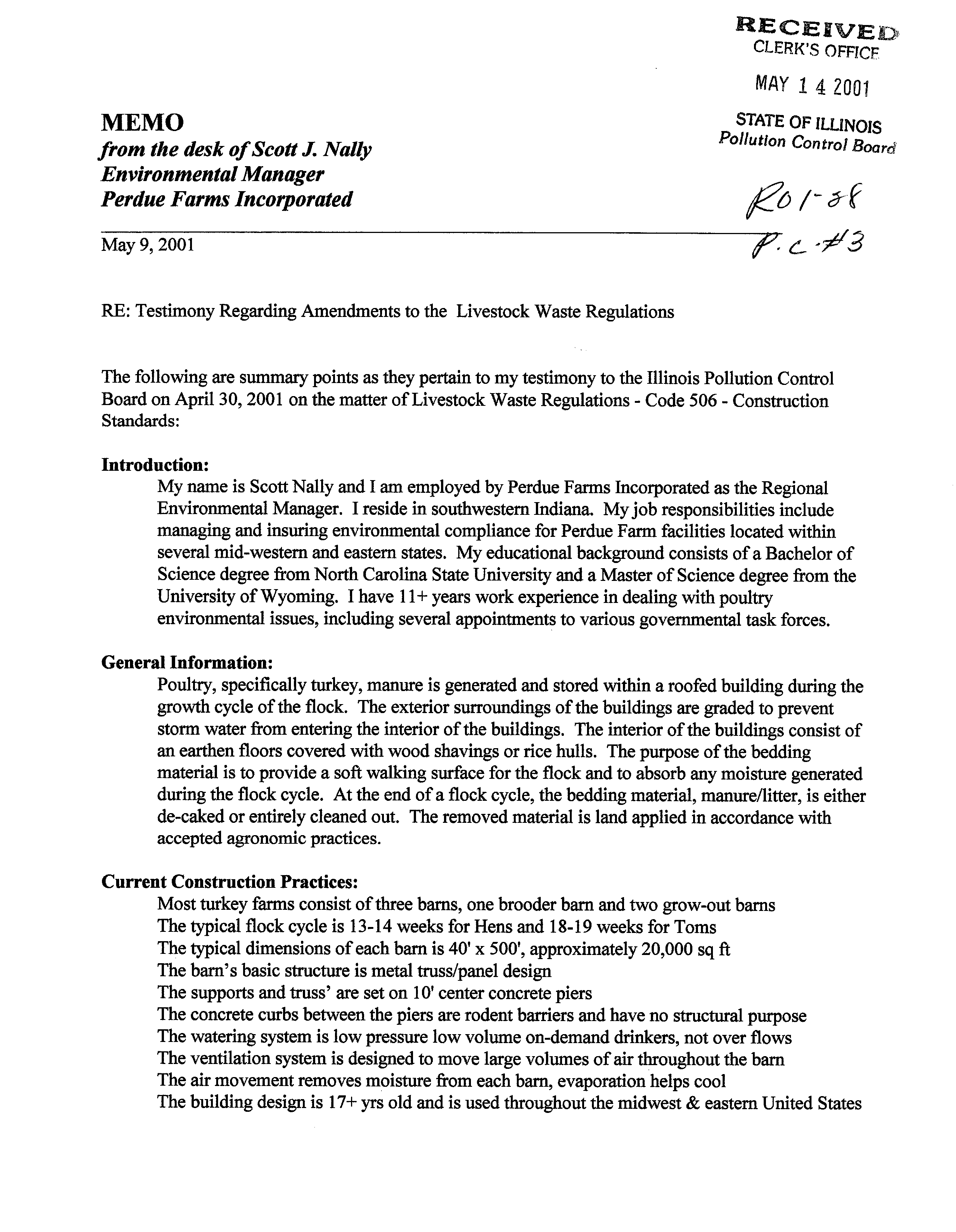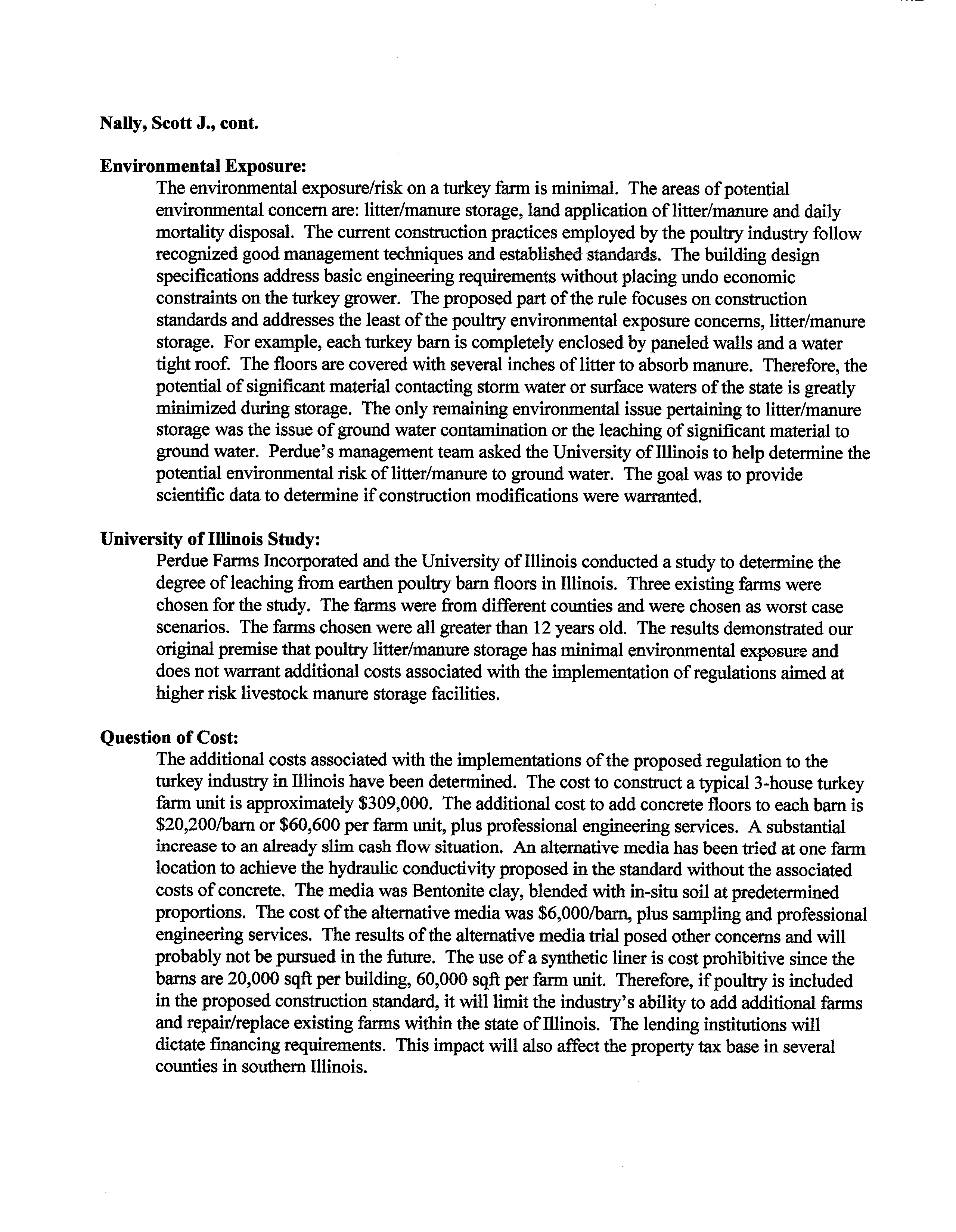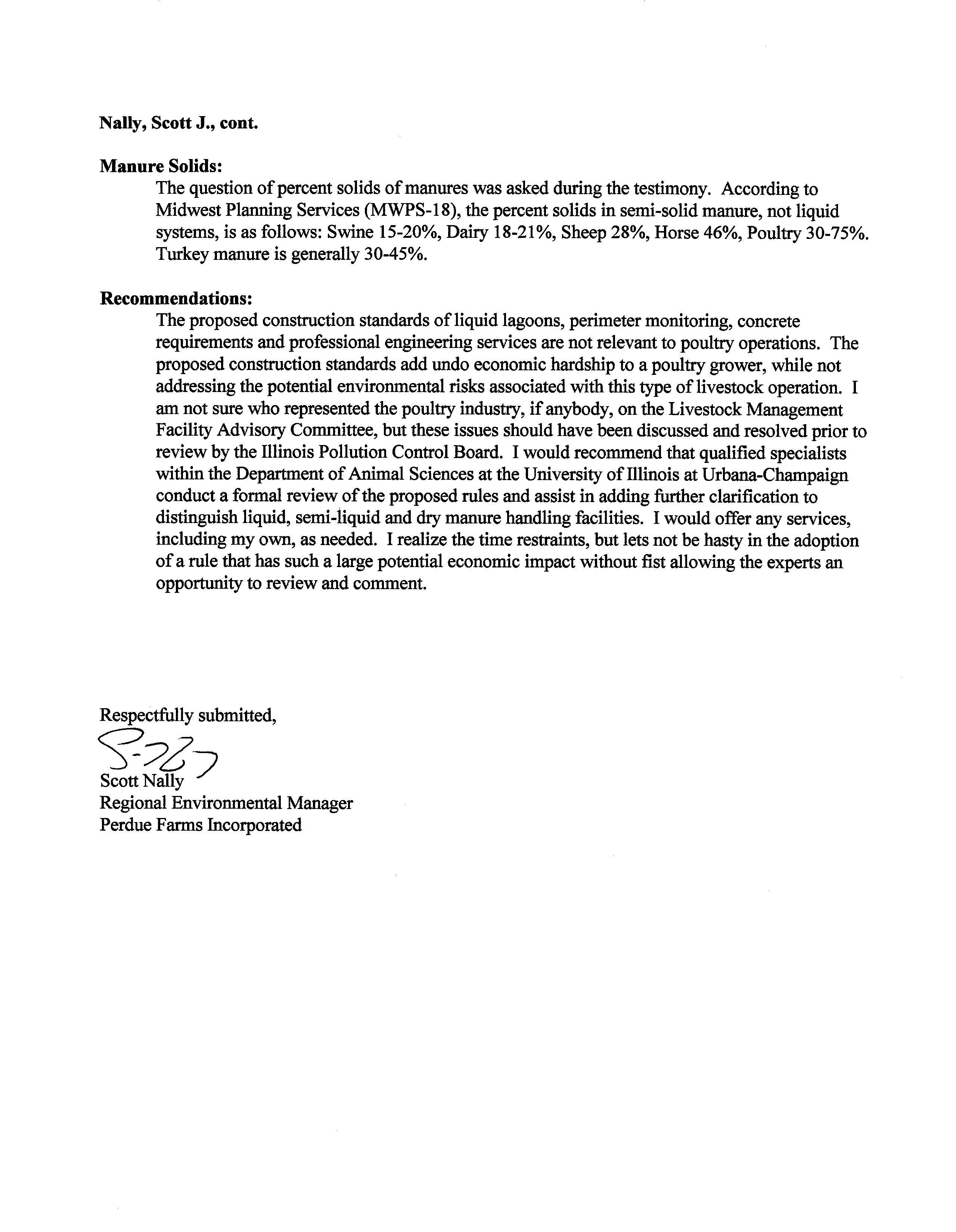CLERK’SOFFICF
MAY 1
4
2001
MEMO
STATE OF ILLINOIS
Pollution
Control Board
from the desk ofScott J. Nally
EnvironmentalManager
Perdue Farms Incorporated
May 9,2001
RE: Testimony Regarding Amendments to the
Livestock Waste Regulations
The following are summarypoints as they pertain to my testimony to the Illinois Pollution Control
Board on April 30, 2001
on the matter ofLivestock Waste Regulations
-
Code
506
-
Construction
Standards:
Introduction:
My name is
ScottNally and I am employed by Perdue Farms Incorporated as the Regional
Environmental Manager.
I reside in southwestern Indiana. Myjob responsibilities include
managing and insuring environmental compliance forPerdue Farm facilities located within
several mid-western and eastern states. My educational background consists ofa Bachelor of
Science degree from North Carolina State University and a Master ofScience degree from the
University ofWyoming.
I have 11+ years work experience in dealing with poultry
environmental issues, including several appointments to various governmental task forces.
General Information:
Poultry, specifically turkey, manure is generated and stored within a roofed building during the
growth cycle ofthe flock. The exterior surroundings ofthe buildings are graded to prevent
storm water from entering the interior ofthe buildings. The interior ofthe buildings consist of
an earthen floors covered with wood shavings orrice hulls.
The purpose ofthe bedding
material is to provide a soft walking surface forthe flock and to absorb any moisture generated
during the flock cycle.
At the end ofa flock cycle, the bedding material, manure/litter, is either
de-caked or entirely cleaned out.
The removedmaterial is land applied in accordance with
accepted agronomic practices.
Current Construction Practices:
Mostturkey farms consist ofthree barns, one brooder barn and two grow-out barns
The typical flock cycle is
13-14 weeks forHens and 18-19 weeks for Toms
The typical dimensions ofeach barn is
40’x 500’,approximately 20,000 sq ft
The barn’s basic structureis metal truss/panel design
The supports and truss’ are set on 10’center concrete piers
The concrete curbs between the piers are rodent barriers and have no structural purpose
The watering system is low pressure low volume on-demand drinkers, not over flows
The ventilation system is designed to move largevolumes ofair throughoutthe barn
The airmovement removes moisture from each barn, evaporation helps cool
The building design is
17+ yrs old and is used throughout the midwest & eastern United States
Nally, Scott J., cont.
Environmental Exposure:
The environmental exposure/risk on a turkey farm is minimal.
The areas ofpotential
environmental concern are: litter/manure storage, land application oflitter/manure and daily
mortality disposal.
The current construction practices employed by the poultry industry follow
recognized good management techniques and established-standards.
The building design
specifications address basic engineeringrequirements withoutplacing undo economic
constraints on the turkey grower.
The proposed part ofthe rule focuses on construction
standards and addresses the least ofthe poultry environmental exposure concerns, litter/manure
storage.
For example, each turkey barn is completely enclosed by paneled walls and a water
tight roof. The floors are covered with several inches oflitter to absorb manure.
Therefore, the
potential ofsignificant material contacting storm water or surface waters ofthe state is greatly
minimized during storage.
The oniy remaining environmental issue pertaining to litter/manure
storage was the issue ofground water contamination or the leaching ofsignificant material to
ground water. Perdue’s management team asked the UniversityofIllinois to help determine the
potential environmental risk oflitter/manure to ground water.
The goal was to provide
scientific data to determine if construction modifications were warranted.
University of Illinois Study:
Perdue Farms Incorporated and the University ofIllinois conducted a study to determine the
degree ofleaching from earthen poultry barn floors in Illinois.
Three existing farms were
chosen for the study.
The farms were from different counties and were chosen as worst case
scenarios.
The farms chosen were all greater than 12 years old.
The results demonstrated our
original premise that poultry litter/manure storage hasminimal environmental exposure and
does not warrant additional costs associated with the implementation ofregulations aimed at
higher risk livestock manure storage facilities.
Question ofCost:
The additional costs associated with the implementations ofthe proposed regulation to the
turkey industry in Illinois have been determined. The cost to construct a typical 3-house turkey
farm unit is approximately $309,000.
The additional cost to add concrete floors to each barn is
$20,200/barn or $60,600 per farm unit, plus professional engineering services.
A substantial
increase to an already slim cash flow situation,
An alternative media has been tried at one farm
location to achieve the hydraulic conductivity proposed in the standardwithout the associated
costs ofconcrete.
The media was Bentonite clay, blended with in-situ soil at predetermined
proportions. The cost ofthe alternative media was $6,000/barn, plus sampling and professional
engineering services.
The results ofthe alternative media trial posed other concerns and will
probably not be pursued in the future. The use ofa synthetic liner is cost prohibitive since the
barns are 20,000 sqft per building, 60,000 sqft per farm unit.
Therefore, if poultry is included
in the proposed construction standard, it will limit the industry’sability to add additional farms
and repair/replace existing farms within the state ofIllinois.
The lending institutions will
dictate financing requirements. This impact will also affect the propertytax base in several
counties in southern Illinois.
Nally, Scott J., cont.
Manure Solids:
The question ofpercent solids ofmanures was asked during thetestimony.
According to
Midwest Planning Services (MWPS- 18), the percent solids in semi-solid manure, not liquid
systems,
is as follows: Swine
15-20%,
Dairy 18-21%, Sheep 28%, Horse 46%, Poultry
30-75%.
Turkeymanure is generally
30-45%.
Recommendations:
The proposed construction standards ofliquid lagoons, perimeter monitoring, concrete
requirements and professional engineering services are not relevant to poultry operations. The
proposed construction standards add undo economic hardship to a poultry grower, while not
addressing the potential environmental risks associated with this type of livestock operation.
I
am not sure who represented the poultry industry, if anybody, on the Livestock Management
Facility Advisory Committee, but these issues should have been discussed and resolved prior to
review by the Illinois Pollution Control Board.
I would recommend that qualified specialists
withinthe Department ofAnimal Sciences at the University ofIllinois at Urbana-Champaign
conduct a formal review ofthe proposed rules and assist in adding further clarification to
distinguish liquid, semi-liquid and dry manure handling facilities.
I would offer any services,
including my own, as needed. I realize the time restraints, but lets not be hasty in the adoption
ofa rule that has sucha large potential economic impact without fist allowing the experts an
opportunity to review and comment.
Respectfully submitted,
51217
Scott Nally
Regional Environmental Manager
Perdue Farms Incorporated



